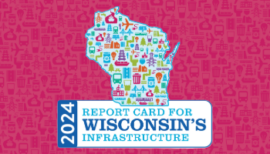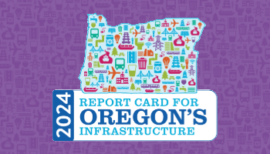Inland Waterways
Startup Uses Drone for Cleaning Water, Collecting Data

Infrastructure is the roads and bridges we travel, water we drink, bays we crab, and reliable energy that powers our electronics. Infrastructure also moves our economy, taking goods from ports to roads to store shelves and transporting workers between their homes and workplaces. While most people might not think about infrastructure every day, Maryland’s civil engineers do – we’ve pledged to build and maintain infrastructure for the public’s health, safety, and welfare.
Our state excels at moving cargo and people efficiently via ports, airports, rails and roads. However, we face challenges when it comes to congestion and population growth. Meanwhile, Maryland’s stormwater and wastewater policies set national precedents for the sectors. However, sanitary sewer overflows still occur. Wastewater and drinking water pipes are aging and some suffer from significant leakage. To continue progress as an economic engine for the country, Maryland must bolster its strategic infrastructure planning. Maryland’s public and private infrastructure owners have been judicious stewards of limited existing resources. Many of Maryland’s asset management policies lead the nation, but closer attention is needed for efforts that integrate sectors and streamline sustainable and resilient engineering solutions.
The Report Card for Maryland’s Infrastructure is a simple tool to help residents, businesses, and policymakers understand and improve Maryland’s infrastructure.
To read about how each category of infrastructure scored, keep scrolling or read the Report Card for Maryland’s Infrastructure Executive Summary.
Aviation is critical to the Maryland economy because well maintained public use facilities are important for attracting and supporting businesses. Maryland’s aviation infrastructure includes 35 public use airports serving both commercial and general aviation needs. BWI Marshall airport is responsible for 99% of enplanements in the state. The airport has invested in capacity in recent years; subsequently, cargo by volume grew 43% in 2017. However, there is still a funding gap of $2.4 billion over the next six years at BWI. Additional funding could be found by increasing the fuel tax as a percentage per gallon to offset reduced gas prices and increasing the Passenger Facility Charge to provide airport modernization and additional capacity.
Maryland’s bridges are improving as the number of structures in poor condition in the state continues to decline. Approximately 5.1% of Maryland’s bridges are listed as poor condition, compared to the national average of 8.4%. This figure has decreased for more than 20 years thanks to a concentrated effort by the Maryland Department of Transportation and the local jurisdictions. However, Maryland bridge owners face growing challenges associated with an aging bridge stock. On average, Maryland bridges are 48 years old, which means they are approaching the end of their 50-year lifespan. Approximately 25% of bridges in Maryland are over 60 years old. Performing routine maintenance and repairs can extend the service life of a bridge, but such maintenance requires funding. With Maryland facing an expected decrease in state and federal funding in the near future, the condition of its bridges is threatened, possibly leading to consequences to the state’s economic competitiveness.
Dams are an essential part of Maryland’s infrastructure that provide critical services such as flood control, water supply, and recreation. There are currently 539 dams in Maryland, approximately 45% of which are high hazard and significant hazard dams. While not indicative of condition, a high or significant hazard classification signals that, in the event of dam failure, there is potential for loss of life, property, and significant impacts on other critical infrastucture. The Maryland Department of the Environment Dam Safety Division (MDE-DSD) is charged with regulating the safety of dams in Maryland. While MDE-DSD is performing better than many other states’ dam safety agencies relative to dam inspections, repairs of deficient dams, and requiring Emergency Action Plans, there is more to be done. Unfortunately, Maryland has no dedicated funding source for repairing dams or ponds, and MDE-DSD’s lack of sufficient resources – personnel and funding – to fully perform all its dam safety duties is concerning.
Maryland residents receive water services from a combination of large water utilities like Baltimore City or Washington Suburban Sanitary Commission, regional systems, and privately-owned wells. The various agencies and different water supply sources serving the state’s residents provide water quality that is generally at or above average national levels. In many of Maryland’s cities and towns, the leading issue related to drinking water is aging infrastructure, which negatively affects the reliability of the water system. Baltimore City has recently averaged nearly 1,000 breaks each year. With limited budgets, infrastructure owners prioritize repairs to maintain service and ensure public safety. For example, approximately 60% of Baltimore City’s Department of Public Works’ total water budget goes toward projects aimed at improving the aging water infrastructure.
Maryland’s electricity is supplied by three separate but integrated groups: generation, transmission, and distribution. Most of the associated infrastructure is operating well past its planned 50-year design life. During peak loads, transmission and distribution needs are at or beyond capacity due to bottlenecks in configuration. Natural gas pipelines that supply electricity-generating assets are often near capacity limits. In 2015, Maryland imported 44% of its electricity as compared to 22% in 2000; this figure is likely to increase as in-state generation declines and population grows. According to PJM Interconnection, a regional transmission organization, while the decline of in-state generation has been considered in Maryland’s overarching system planning, it is still likely to impact resilience due to risks to electricity supply, especially during severe regional weather events. Without greater attention to aging infrastructure, integration of resilience into infrastructure planning, and incorporation of renewable energy technologies, Maryland will likely experience longer and more frequent power interruptions.
Maryland ports are vital links for freight and raw materials, moving over 40 million tons of cargo annually. In 2018, the Port of Baltimore was ranked the 11th largest U.S. port by tons and 9th largest by dollar value of freight moved; it was responsible for $5.9 billion of economic activity in the state. Jobs associated with the Port of Baltimore represent 7% of the Maryland workforce and nearly 3% of the total wages earned in the state. Awarded as the most efficient for container berth productivity in recent years, the Port of Baltimore has prioritized infrastructure and operational improvements including an asset management program which enhances its capacity and efficiency. The Port’s capital budget has more than doubled over the last seven years and it is making investments that will allow continual growth. However, the area’s limited footprint may constrain future expansion and access options for multiple modes of transportation, both of which could impede capacity.
One of the first railroads in the United States, the B&O Railroad was constructed in Maryland in 1827 to connect Baltimore seaports westward and towards the south. Today, the Maryland rail network consists of approximately 1,150 miles of track and carries over 90 million tons of freight worth $5.4 billion. Yearly, the Maryland Area Regional Commuter train carries 9 million passengers while over 2 million Amtrak passengers board or alight at Maryland stations. Maryland rail infrastructure is primarily privately owned by freight operators who make significant investments in infrastructure upgrades, with $62.5 million invested by CSX and $4 million invested by Norfolk Southern in 2015 and 2016, respectively. However, according to the statewide rail plan, freight and passenger rail collectively face a funding gap of more than $3 billion to fully modernize infrastructure and meet growing demands.
The condition of Maryland’s roadways has modestly improved since 2011; approximately 80% of pavement condition for county and city roads is assessed as Fair to Very Good. However, roadway capacity continues to lag in meeting travel demand during peak hours with heavy to severe congestion occurring on 254 miles (15%) of the freeway/expressway network. Maryland Department of Transportation projects and programs have been developed to provide benefits for more than 700,000 motorists and countless multi-modal users to yield a safe and modern transportation system. As of 2019, their efforts in combination with other initiatives resulted in more than $1.6 billion of annual user savings due to lowered delays, fuel consumption, and emissions. Advancements in technology, better asset management, and efforts to preserve roadways have improved the state’s infrastructure and provided a way to spend roadway funding more wisely. However, as Maryland’s vehicle miles traveled continues to increase, every effort should be made to leverage revenue sources to fill the funding gap necessary to maintain a state of good repair and provide roadway enhancements.
Maryland generates 4.6% of the nation’s total density of solid waste despite containing less than 2% of the population. While this has the potential to be concerning, Maryland’s residents recycle at higher rates than the national average, 2.68 pounds per person per day, compared with 1.51 pounds per person per day nationally. At this point, local capacity and funding are adequate to accommodate the state’s solid waste needs, supporting ongoing programs and facilities while maintaining stable rates. However, solid waste management systems throughout the state may struggle in the future to meet changing community needs, regulatory requirements, and mandates. For example, the impacts from climate change to the eastern part of the state are not fully known and could jeopardize the infrastructure’s capacity. With the state population increasing roughly 1% a year and constrained resources for funding waste disposal, the availability of that capacity is a concern beyond 2050. This justifies the need for state-wide improvements in solid waste management including an expansion of the state’s recycling infrastructure and increased diversion of organics.
The Maryland Department of the Environment administers stormwater permits in the state. The agency’s stormwater management efforts are regarded as some of the most innovative nationwide. Since 2000, when MDE began upgrading its then-outdated stormwater management plan, its forward-thinking vision has been reflected in both Maryland stormwater policies and databases. However, the state faces significant challenges. The Chesapeake Bay water quality has been steadily declining over the last few decades. In 2010, new limits on the amount of pollutants that can enter the body of water were set, but statewide stormwater costs to comply with these regulations are projected to be more than $3 billion. The cost of building supporting infrastructure mostly falls to local municipalities and the state, taxing their already limited resources.
Two major transit agencies operate in the state: the Maryland Department of Transportation Maryland Transit Administration (MDOT MTA) and the Washington Metropolitan Area Transit Authority (WMATA). MDOT MTA supports 103.6 million annual unlinked passenger trips, manages 487 miles of track, and operates 1,986 vehicles. Cross-jurisdictionally (Maryland, Washington, DC, and Virginia), WMATA supports 352.5 million annual unlinked passenger trips, manages 234 miles of track, and operates 3,633 vehicles. Although Maryland continues to embark on planning efforts for transit system improvements and expansion, the eight-year constant decline in ridership is indicative of systemic issues. Such challenges are further complicated by significant budget shortfalls (for MDOT MTA and WMATA) to achieve a state of good repair and improve on-time goals across all modes. Meanwhile, various initiatives in rural Maryland counties aim to improve the fluidity among systems and improve the transit access gap.
Maryland’s wastewater infrastructure systems range in size from household septic systems to large-scale wastewater treatment plants. These systems are designed to effectively manage day-to-day operations and wet weather flows for households and communities across the state. There are several legacy systems over 150 years old that have been upgraded and expanded many times. Fortunately, many of these upgrades have reflected Maryland’s national leadership in implementing both advanced wastewater treatment systems and innovative funding mechanisms. One such funding mechanism is the Bay Restoration Fund, a state grant funding program, paid for with a monthly $5/household “flush tax.” Despite the gains in water quality, Maryland continues to face significant challenges, including reducing the sanitary sewer overflows, leakage from urban areas that have aging pipes, and quantity of inadequate or failing privately-owned septic systems.
A: EXCEPTIONAL, B: GOOD, C: MEDIOCRE, D: POOR, F: FAILING
Each category was evaluated on the basis of capacity, condition, funding, future need, operation and maintenance, public safety, resilience, and innovation

Aviation
$33.3 million in 2022 airport improvement grants across 3 major airports

Drinking Water
$14.6 billion total drinking water need

Transit
217 million passenger trips across 23 systems in 2022

Bridges
5,446 bridges, 4.6% of which were structurally deficient in 2021

Hazardous Waste
26 Superfund sites

Wastewater
$9.9 billion total wastewater need

Dams
103 high hazard dams

Levees
30 miles of levees protect 15,999 residents.

Roads
48% of roads are in poor or fair condition
Smart investment will only be possible with strong leadership, decisive action, and a clear vision for our nation’s infrastructure.
If the United States is serious about achieving an infrastructure system fit for the future some specific steps must be taken, beginning with increased, long-term, consistent investment.
We must utilize new approaches, materials, and technologies to ensure our infrastructure can withstand or quickly recover from natural or man-made hazards.

Wisconsin’s infrastructure Report Card grade improves in 2024
September 17, 2024
On September 17th, the Wisconsin Section of ASCE released the 2024 Report Card for Wisconsin’s Infrastructure at the state capitol building in Madison. The Report...

Infrastructure Is on the Ballot in 2024
August 23, 2024
Infrastructure Initiatives in Upcoming State Elections Labor Day weekend traditionally signals the end of summer and the start of a frenzied sprint to Election Day....

Oregon Infrastructure Report Card Receives a ‘C-’ in 2024
August 07, 2024
On Tuesday, August 6th, the Oregon section of the American Society of Civil Engineers (ASCE) released the 2024 Report Card for Oregon’s Infrastructure outside the...